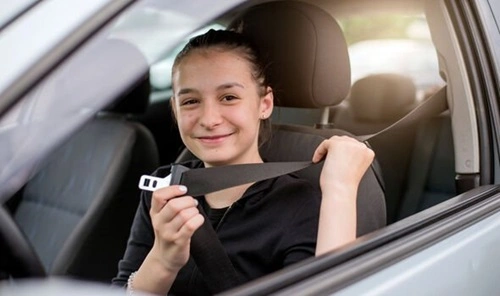The legal driving age in most U.S. states is 16, but some states allow 15-year-olds to obtain a learner’s permit under graduated driver licensing (GDL) programs. However, a growing debate suggests that 15-year-olds should be allowed to drive independently under specific conditions.
Supporters argue that early driving privileges can teach responsibility, prepare teens for adulthood, and help families with transportation challenges. With proper training, education, and parental supervision, allowing 15-year-olds to drive may be a safe and practical solution to modern transportation needs.
This article explores why 15-year-olds should be able to drive, backed by expert insights, safety measures, and real-world examples.
1. Early Driving Prepares Teens for Adulthood

Driving is an essential life skill that teaches responsibility, independence, and critical decision-making.
How Driving Builds Maturity
Decision-Making Skills – Operating a vehicle requires quick thinking and problem-solving.
⏳ Time Management – Teens must plan routes, manage time, and adhere to schedules.
Personal Responsibility – Drivers must follow traffic laws, maintain a vehicle, and handle emergencies.
A 2023 study by the National Highway Traffic Safety Administration (NHTSA) found that teens who start driving earlier develop better hazard awareness and lower risk-taking behaviors compared to those who start later.
By introducing driving at 15, teens can develop confidence and competence earlier, making them safer drivers in the long run.
2. Helps Families with Transportation Challenges
Many families struggle with transportation logistics, especially in rural areas or households with working parents.
How Early Driving Helps Families
Reduces Parental Burden – Parents don’t have to constantly shuttle teenagers to school, work, or extracurricular activities.
Fills Gaps in Public Transit – Many rural areas lack reliable bus or ride-sharing services, making driving essential.
Improves Scheduling Flexibility – Teens with jobs, sports, or volunteer work can drive themselves, increasing productivity.
According to the 2023 U.S. Census, over 30% of American households have two working parents, making it difficult to manage teen transportation needs. Allowing responsible 15-year-olds to drive can ease this burden.
3. A Graduated Licensing System Can Ensure Safety
Critics argue that 15-year-olds lack the maturity and experience to drive safely. However, graduated driver licensing (GDL) programs provide a structured, step-by-step approach to ensure safe learning.
Proposed Safe-Driving Restrictions for 15-Year-Olds
✔️ Parental Supervision Required – Teens must log a certain number of supervised hours before full independence.
✔️ Daytime-Only Driving – No nighttime driving until they gain more experience.
✔️ Passenger Limits – Only family members or one passenger allowed to prevent distractions.
✔️ Zero Tolerance for Distracted Driving – Strict penalties for texting or phone use while driving.
According to the Insurance Institute for Highway Safety (IIHS), states with GDL programs have seen a 40% reduction in teen crash rates.
By enforcing progressive driving privileges, 15-year-olds can learn safely while gaining real-world experience.
4. Other Countries Allow Teen Driving with Success
Many countries have lower driving ages and still maintain safe roads and responsible drivers.
Examples of Early Driving Success
Australia – Learner permits available at 15 years old with a mandatory training period.
New Zealand – Allows restricted driving at 15, with strict nighttime and passenger rules.
Canada – Some provinces allow 15-year-olds to drive with parental supervision.
In these countries, structured training, strict enforcement, and driver education create a safe learning environment for young drivers. The U.S. can adopt similar successful policies to make 15-year-old drivers responsible and prepared.
5. Encourages Early Safe Driving Habits
Allowing 15-year-olds to start driving under controlled conditions teaches them safe habits before they become fully independent drivers.
Benefits of Early Training
Better Hazard Detection – Younger drivers learn to anticipate dangers before they develop bad habits.
Lower Crash Rates Over Time – Studies show that drivers who start with structured learning at a younger age become safer adult drivers.
More Experience Before College – Teens who learn early are better prepared for driving independently when they leave for college or work.
A 2024 study by the University of Michigan Transportation Research Institute found that early exposure to supervised driving reduces crash risk by 30% in later years.
Starting at 15 instead of 16 gives teens an extra year of guided learning, making them more responsible and skilled drivers.
Frequently Asked Questions (FAQs)
1. Are 15-year-olds mature enough to drive?
With proper training, most 15-year-olds can handle the responsibility of driving. A graduated licensing system ensures they gain experience before full independence.
2. Isn’t it more dangerous to have younger drivers on the road?
Younger drivers are at higher risk, but states with strong GDL programs have lower teen crash rates. Early training under supervision makes driving safer.
3. What restrictions should be in place for 15-year-old drivers?
- Parental supervision for a set number of hours
- No night driving until they gain experience
- Passenger limits to reduce distractions
- Strict no-phone policies while driving
4. What states already allow 15-year-olds to drive?
Several states, including South Dakota, Montana, and North Carolina, allow 15-year-olds to get a learner’s permit with restrictions. Some states even allow restricted licenses for rural residents.
5. How can parents ensure their 15-year-old drives safely?
- Enroll them in a driver education course
- Set clear rules and expectations
- Use driving apps to track habits and location
- Drive with them regularly to reinforce safe practices
Conclusion: A Safe Path to Early Driving
Allowing 15-year-olds to drive under a graduated licensing system offers numerous benefits:
✅ Prepares teens for adulthood by teaching responsibility
✅ Helps families with transportation challenges
✅ Encourages safe driving habits at an early age
✅ Provides more supervised experience before full independence
With proper training, strict rules, and parental guidance, 15-year-olds can become safe, responsible drivers. Instead of delaying driving privileges, we should implement structured programs to help them gain real-world experience in a controlled environment.
The road to safer, more responsible drivers starts with early education—let’s give 15-year-olds a chance to prove they’re ready.



